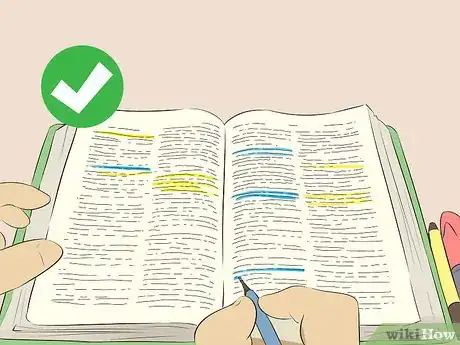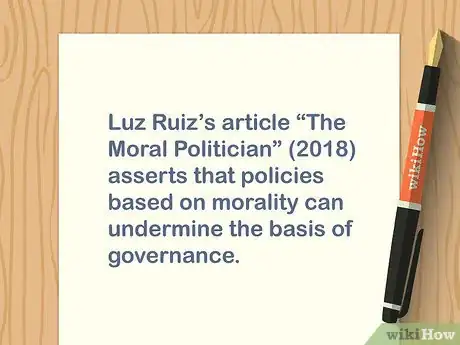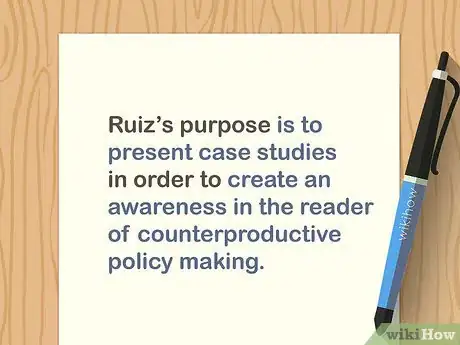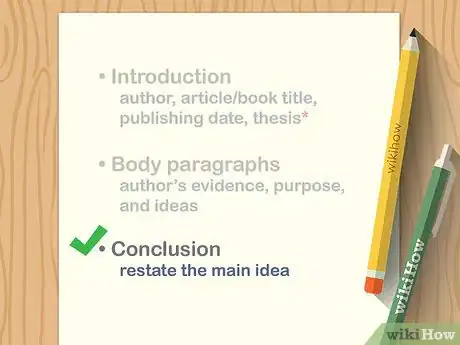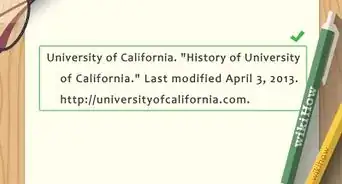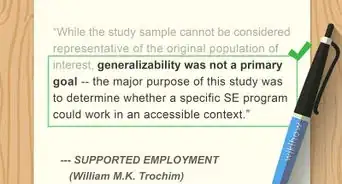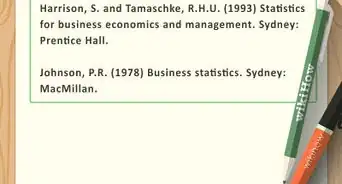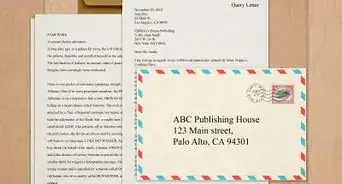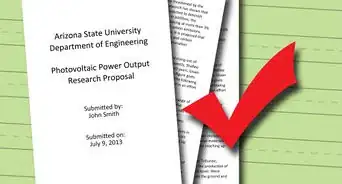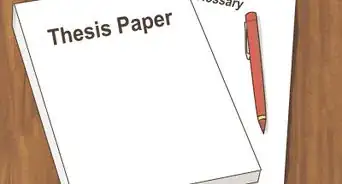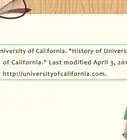This article was co-authored by Christopher Taylor, PhD and by wikiHow staff writer, Danielle Blinka, MA, MPA. Christopher Taylor is an Adjunct Assistant Professor of English at Austin Community College in Texas. He received his PhD in English Literature and Medieval Studies from the University of Texas at Austin in 2014.
This article has been viewed 157,809 times.
A précis is a summary of a written work, such as an article, book, or other text. You’ll objectively explain the original text’s main argument, support, and structure, without doing a critical analysis. Although it might seem challenging at first, don't get discouraged! It's simple once you understand the structure. Before you can write your précis, you’ll need to study the text. When writing your précis, use the correct structure and style guidelines.
Steps
Studying the Text
-
1Read the text your précis will summarize. Take your time to work your way through the text. Make sure you have a clear understanding of the author’s argument, their support for their argument, and how they made their argument.[1]
- You’ll likely need to read the text several times. You might read a novel twice, but you could read a shorter work 3-5 times.
- Skim over the text before you read it, mentally dividing it into sections. If the text has headings and/or subheadings, use these as a guide. Otherwise, you can divide it by paragraph.
- If you notice any unfamiliar words, look them up.
-
2Annotate the text. Annotating means marking your text to identify important information and make notes to yourself. It’s important to annotate when writing a précis because it shows you how you interact with a text, and how you've come to understand it over time. Additionally, it’ll help you decide what’s important enough to include in your précis.[2]
- If you learn well visually, use different colored highlighters to highlight the thesis, supporting arguments, and important details.
- Write notes in the margins to explain important arguments in your own words.
Advertisement -
3Restate the text’s thesis using your own words. The author’s thesis contains their argument, which is essential for your précis. In some cases, it will also clearly point out the evidence they use to back up the argument. Look for the thesis in the beginning of the text.[3]
- In a longer text, you may need to do a close reading to find the thesis. You should consider the author's arguments and main ideas. Remember, the thesis is the author's controlling idea. For instance, a novel likely won't have a clear thesis, but you could identify what the author is trying to prove or show.
- For examples of how to do this, look at book reviews in literary journals or in major newspapers. Remember not to simply copy the thesis, which is considered plagiarism.
-
4Summarize each section of the text using 1-2 sentences. It’s up to you to determine how big your sections should be. You might divide the text into sections using headings, subheadings, or chapters, or you might consider each paragraph a section. Look back at the guide you came up with while you were reading, in which you mentally divided the text into main headings and subheadings. Remember that more sections will make it harder to condense your summaries into a précis, but sometimes it’s necessary to have more sections in order to fully understand the text.[4]
- Consider the length and difficulty of the text when dividing your sections. There’s no wrong way to section an article.
- For example, when writing a précis for a novel, you could summarize each chapter. If it's a journal article that's already divided into sections, you could summarize these sections. For an essay or article without sections, you could summarize each paragraph.
- Be sure to only include the key point and evidence in your summary.
- Include enough information in your summaries so that you don’t need to refer to the main text to understand them.
-
5Determine the author’s purpose for writing the text. What was the author trying to accomplish? What do they want the reader to do, think, feel, or believe after reading the text? These questions will help you find their purpose. You’ll explain this purpose in your précis.[5]
- The author likely won’t state their purpose, so you’ll need to determine it yourself. Consider your reaction to the text. For example, did it make you think? Do you feel differently about the subject? This can help you figure out the purpose.
- If you're writing a précis about a short story or novel, the author may be entertaining the reader, but they will also have a message behind the story. This message can help you find the purpose.
- If you're writing a précis about an article or essay, the purpose may be related to the thesis. What is the writer trying to prove? How does that connect to their purpose? For instance, the author's purpose might be to change the way you think about recycling paper. Their thesis could read, "Reusing paper before recycling it is better for the environment because it reduces new purchases of paper, produces less waste, and lowers energy expenditures by recycling programs."
- You can also look at a few published reviews of the book, which can give you good contextual information and different perspectives to orient your understanding of the purpose.
-
6Create a brief outline of the argument, if you need it. An outline can help you better understand the author’s argument and supports, but it isn’t necessary. Write the thesis at the top of your outline. Then, make each piece of evidence backing up the thesis a main point. Finally, include any other supports as subpoints, if necessary.[6]
- An outline lets you see how the argument is assembled.
- This outline is just for you, so don’t worry if it’s messy.
-
7Compare your summaries to the original text. Reread the original text with your summaries at hand. As you read, go back and forth between the texts to make sure what you have written corresponds to what the author actually meant. If necessary, make corrections to your work.[7]
- Remember to use your own words. However, you need to accurately portray the meaning of the original text.
Structuring Your Précis
-
1Introduce the author, genre, date, and topic in the first sentence. Although this is a lot of information, you’ll present it concisely. It should only take you 1 sentence to introduce the work this way.[8]
- In rare cases, you may need to provide more information about the author, but this is only necessary if that information is necessary to understand the précis. For example, let's say an astronaut wrote a scholarly article about how being on the space station affected their research. It would be helpful to include that the author had been to space, as it adds to their credibility.
- Put the date in parentheses after the title.
- The genre refers to the type of text, such as article, short story, novel, play, etc.
- Use a rhetorical verb, such as asserts, explains, argues, refutes, proves, or disproves, to introduce the author’s argument.
- Here’s an example: Luz Ruiz’s article “The Moral Politician” (2018) asserts that policies based on morality can undermine the basis of governance.
-
2Explain how the author supports their argument in the second sentence. Focus on the rhetorical method the author used, not specific details of their argument. Provide the type of evidence and supports used by the author. For example, “Ruiz makes this argument by comparing and contrasting policy case studies and citing research studies about the impact of morality policy on communities.” Here are some types of evidence you might see:[9]
- Comparing and contrasting of 2 or more things.
- Providing several small arguments.
- Offering 1 long chain of argument.
- Illustrating a point.
- Creating a narrative.
- Citing research.
- Defining and elaborating on the terms of the thesis.
-
3Provide the purpose of the text in the third sentence. The purpose is what the author is trying to achieve with their text. To find the purpose, ask yourself what the author wants the reader to think, believe, feel, or do about the topic. Connect these ideas with the phrase "in order to.”[10]
- The purpose is the author’s motive, not the thesis.
- For instance, “Ruiz’s purpose is to present case studies in order to create an awareness in the reader of counterproductive policy making.”
-
4Describe the intended audience in the fourth sentence. When identifying the audience, you need to explain your rationale for your conclusions. You might consider the background information provided by the author, as well as the knowledge they presume the reader to have.[11]
- Since the author won’t directly tell you their intended audience, you’ll need to use cues from the article to determine it. Cues to watch for include the type of language used, the types of references, and the author’s background. You might compare and contrast the article to other similar articles to determine if it's more formal or informal. For example, academic or professional articles might use a lot of jargon, and they may expect the reader to understand references to other ideas in the field. However, articles written for the casual reader might use down-to-earth language and may thoroughly explain references to other ideas.
- For instance, “Based on her use of jargon and the nature of the topic, Ruiz primarily writes for an audience who understands policy debate, such as policy students, academics, and politicians.”
-
5Expand on the supporting arguments, if you’re writing a long précis. You will still include your 4-sentence explanation as above, but you’ll also include short paragraphs concisely explaining each of the supporting pieces of evidence. You'll include the author's argument and the type of evidence used. These short paragraphs should be similar to sentence 2 in a typical précis.
- This type of précis is less common than the 4-sentence structure presented above.
- You should only write a long précis if your instructor asks for it. Always check your assignment details.
-
6Include a 2-sentence conclusion in a long précis. You only need to write a conclusion if you've been assigned a long précis. To conclude, you’ll restate the thesis and provide a 1-sentence summary of the type of evidence the author used.[12]
- Remember, you don't need to incorporate any outside ideas or conclusions you have made, as a précis is only about the work itself.
- Keep your conclusion concise.
Revising Your Précis
-
1Read your précis, noting areas that need work. Highlight or underline parts that need revision or areas you think don’t quite make sense. Make sure you correctly followed the structure listed above.[13]
- It’s a good idea to look for typos, grammar errors, or spelling issues now, but you’ll still need to proofread your final draft.
-
2Compare your précis to the original text. Make sure you accurately presented what the author is trying to say. If you aren’t sure it matches, it’s best to rework your précis. Since a précis is so short, every word counts!
- For example, re-read the original text, then re-read your précis.
- If you can, have someone read both the original text and your précis and tell you what they think.
-
3Make revisions as necessary to improve your work. Use your notes and any feedback you receive from others to correct your précis, if necessary. Your final text should be as concise as possible.[14]
- For example, you might eliminate redundant text or extra words that aren't necessary.
- If you make substantial changes, it’s best to compare it to the original text once again.
-
4Proofread your précis. Check for grammar and spelling errors, as well as typos. Make any corrections necessary.[15]
- If you can, ask someone to proofread your work for you, as you might overlook some of your own errors.
Following Best Practices
-
1Check with your instructor for specific formatting requirements. Although there are strict structural recommendations for writing a précis, your instructor may have their own purpose for assigning it. Additionally, longer texts may require more explanation than shorter texts. It’s important to check these specifications before you get started.[16]
- Although a précis is always concise, its length can vary depending of the length of the original work and your instructor’s preferred length.[17] For an article, your précis will likely be 100-200 words long, but a longer work may require a few pages of text. Expect your précis to be about 1/5 to 1/6 the length of the original text.[18]
- Read over your assignment sheet carefully.
-
2Write in the present tense. Treat the text as a living document, which is always in the present. Even if the author wrote the text decades ago, you’ll still write as though they’re making their arguments now.
- For instance, you should write “Ruiz proves” not “Ruiz proved.”
- Make sure your verbs apply to the author, not the text. For example, “Ruiz argues” not “the article argues.”
-
3Make sure you don’t include your own opinions. Your précis should clearly explain the original author’s argument, support, and structure in your own words. However, you shouldn’t offer any of your own opinions, such as commentary or an added argument. This is not a critical piece.[19]
- Stay objective throughout the writing process.
-
4Avoid directly quoting the original text. Your précis will be a concise summary, so it shouldn’t include any quotes. Using quotations would undermine the purpose of your thesis. You don’t want your text to be too wordy.[20]
- It’s okay to quote a special term coined by the author if it’s important to the précis. For example, "freakonomics" is a special term created by economist Steven Levitt and journalist Stephen J. Dubner. It's not a normal word, so you would put quotes around it when including it in a précis.
Community Q&A
-
QuestionWhat is the difference between a precis and a reflection paper?
 Community AnswerA precis is a summary of the paper, a reflection is where one gives their opinion about the paper.
Community AnswerA precis is a summary of the paper, a reflection is where one gives their opinion about the paper. -
QuestionCan I use numbers and years in my precis?
 Community AnswerYes it is very important to highlight the numbers and years of original text in your Précis.
Community AnswerYes it is very important to highlight the numbers and years of original text in your Précis.
References
- ↑ https://writing.wisc.edu/handbook/assignments/nonfictionanalysis/
- ↑ https://writing.wisc.edu/handbook/assignments/nonfictionanalysis/
- ↑ https://downloads.wlu.ca/downloads/academics/support-and-advising/documents/writing-a-precis.pdf
- ↑ https://downloads.wlu.ca/downloads/academics/support-and-advising/documents/writing-a-precis.pdf
- ↑ https://downloads.wlu.ca/downloads/academics/support-and-advising/documents/writing-a-precis.pdf
- ↑ https://www.monmouth.edu/resources-for-writers/documents/how-to-write-a-precis.pdf/
- ↑ https://downloads.wlu.ca/downloads/academics/support-and-advising/documents/writing-a-precis.pdf
- ↑ https://writing.wisc.edu/Handbook/nonfictionanalysis.html
- ↑ https://writing.wisc.edu/Handbook/nonfictionanalysis.html
- ↑ https://writing.wisc.edu/Handbook/nonfictionanalysis.html
- ↑ https://writing.wisc.edu/Handbook/nonfictionanalysis.html
- ↑ https://downloads.wlu.ca/downloads/academics/support-and-advising/documents/writing-a-precis.pdf
- ↑ https://www.monmouth.edu/resources-for-writers/documents/how-to-write-a-precis.pdf/
- ↑ https://www.monmouth.edu/resources-for-writers/documents/how-to-write-a-precis.pdf/
- ↑ https://www.monmouth.edu/resources-for-writers/documents/how-to-write-a-precis.pdf/
- ↑ https://writing.wisc.edu/Handbook/nonfictionanalysis.html
- ↑ http://writingcenter.tamu.edu/Students/Writing-Speaking-Guides/Alphabetical-List-of-Guides/Academic-Writing/Precis
- ↑ https://www.monmouth.edu/resources-for-writers/documents/how-to-write-a-precis.pdf/
- ↑ https://writingcenter.tamu.edu/Students/Writing-Speaking-Guides/Alphabetical-List-of-Guides/Academic-Writing/Precis
- ↑ https://www.monmouth.edu/resources-for-writers/documents/how-to-write-a-precis.pdf/
- ↑ https://writing.wisc.edu/Handbook/nonfictionanalysis.html
About This Article
Before writing a précis, make sure that you’ve read through the text and made notes in the margins to help you identify the most important points. Afterwards, begin your precis by restating the thesis, or the author’s main argument, in your own words. Then, summarize each paragraph, section, or chapter in 1 to 2 sentences. Make sure to only include information that supports the main argument in your summary. Additionally, include enough information so that you don’t need to refer to the main text in order to understand the summary. For more advice, including how to structure or revise your précis, keep reading.

